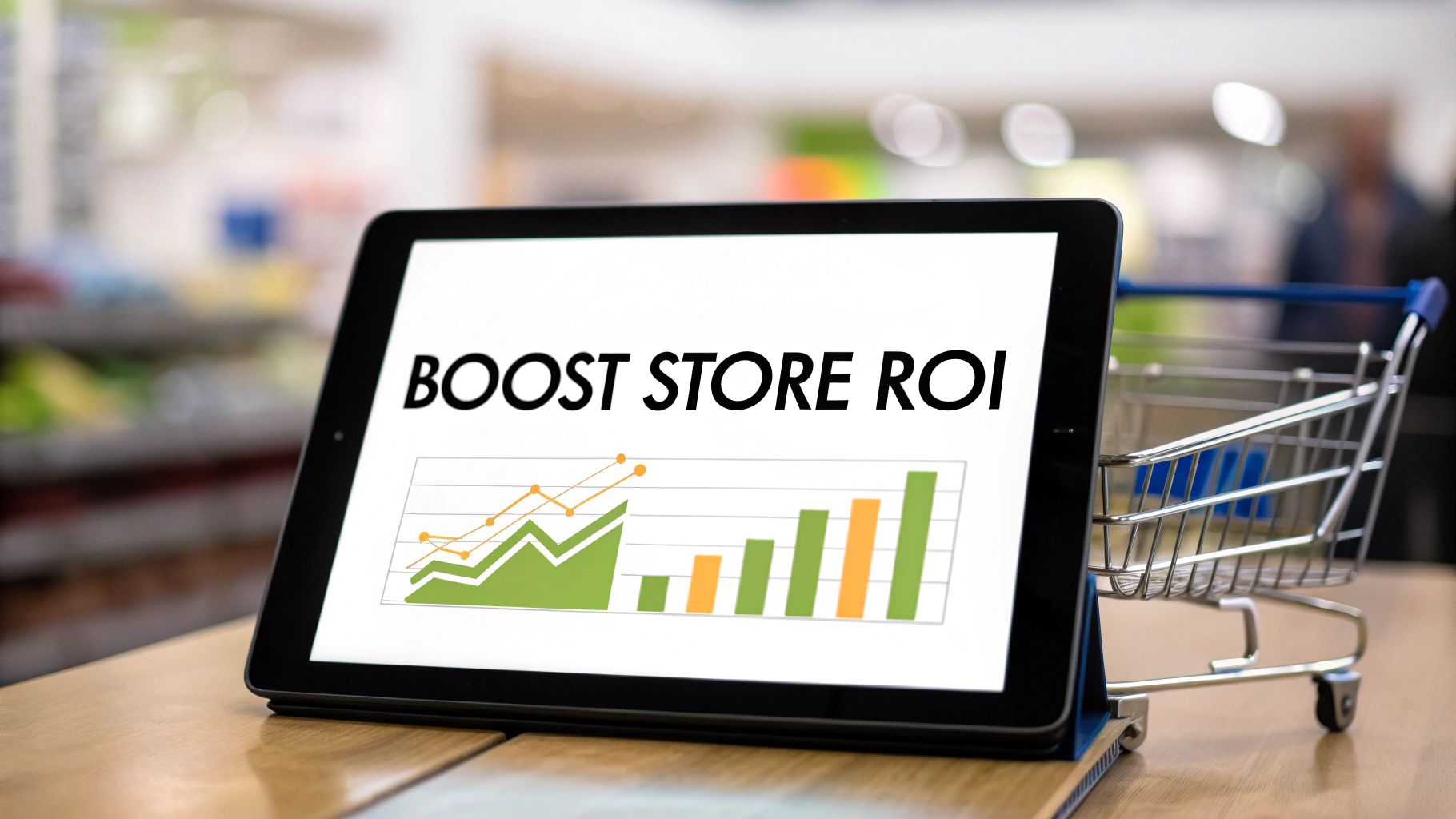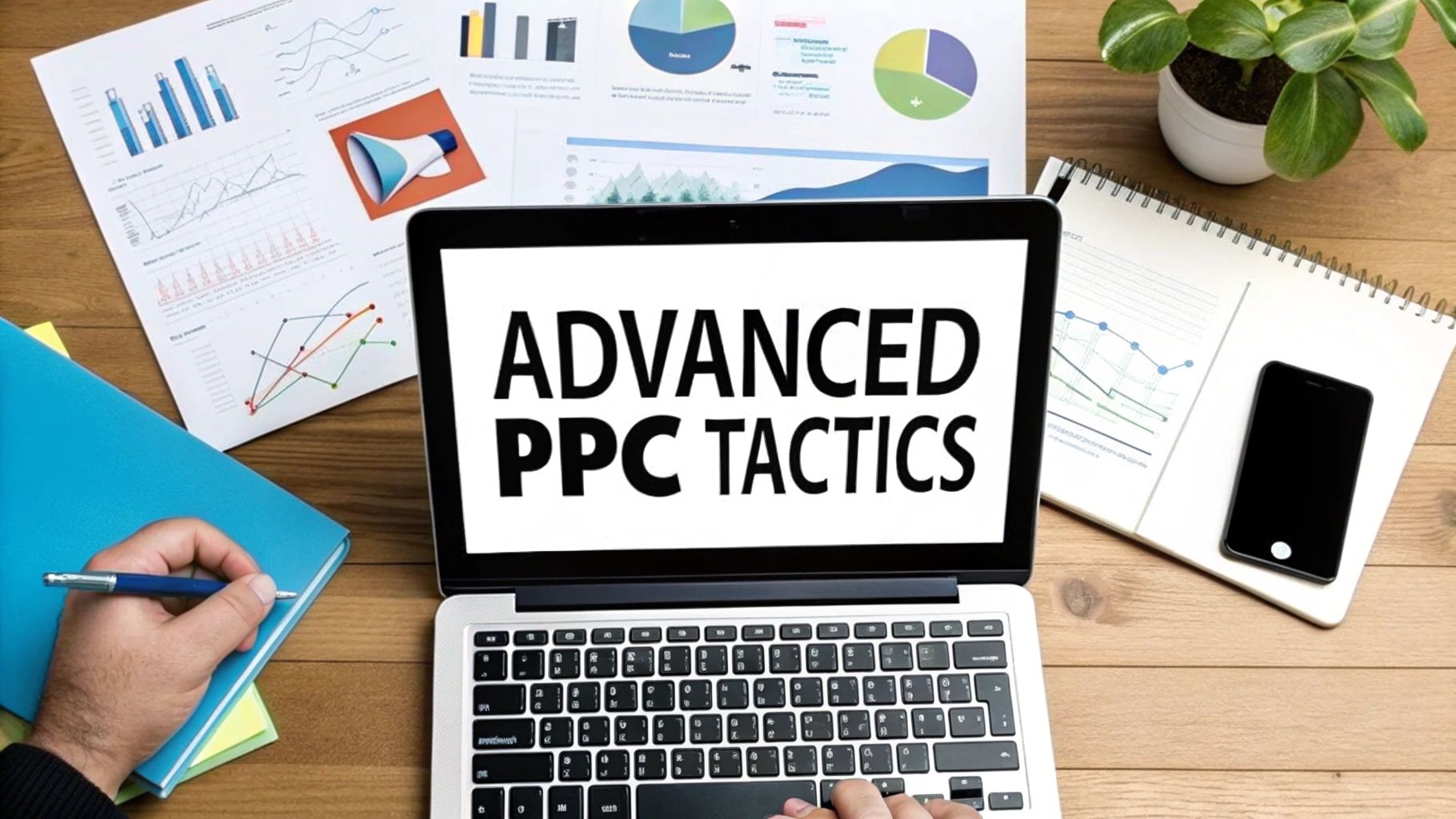What Is View Through Conversion and Why It Matters
- Chase McGowan
- 55 minutes ago
- 10 min read
Ever heard of a view-through conversion (VTC)? It’s when a customer sees one of your ads, doesn't click it, but then heads to your website on their own and converts later. This is where you start measuring the real, subtle influence and brand recall your ads are generating—even when there’s no immediate interaction.
The Hidden Metric That Reveals Your Ad's True Power
Most advertisers are obsessed with clicks. It’s an easy metric to get your head around: someone saw an ad, clicked it, and hopefully bought something. This is a click-through conversion (CTC), and it's the primary metric many overpriced, bloated agencies focus on because it's simple to slap on a report.
But what about all those ads people see but don't click?
This is where the real story of your ad's influence is hiding, and it’s where an expert consultant digs deeper than a standard agency. Think of a VTC like a killer assist in basketball; it’s the critical pass that sets up the final shot, even if it doesn't get the same glory on the scoreboard. It measures the subconscious nudge your ads give a potential customer along their journey.
The simple flow below shows you exactly how it works.

As you can see, a conversion can happen long after the initial impression, which is why looking beyond immediate clicks is so important.
View Through vs Click Through Conversion at a Glance
To make this crystal clear, let's break down the fundamental differences between the two main types of conversion tracking in Google Ads.
Attribute | View Through Conversion (VTC) | Click Through Conversion (CTC) |
|---|---|---|
User Action | Sees an ad, does not click, converts later | Sees an ad, clicks it, then converts |
Campaign Type | Primarily measured for Display & Video campaigns | Measured for Search, Shopping, Display, & Video |
Attribution | Last ad impression gets the credit | Last ad click gets the credit |
What It Measures | Brand awareness and ad recall influence | Direct response and immediate user intent |
Typical Use Case | Top-of-funnel brand building campaigns | Bottom-of-funnel, direct-response campaigns |
Essentially, CTCs show you who responded right away, while VTCs reveal who you influenced over time. Both are critical for a holistic view of your performance.
Why VTCs Are Essential for Smart Advertising
If you ignore VTCs, you're missing a massive piece of the puzzle. Since platforms like Google Ads introduced them back in 2009, they've become absolutely vital for understanding the true impact of display and video campaigns. In fact, some data shows that up to 95% of purchases are preceded by someone seeing a display ad, highlighting the incredible influence of impressions.
A skilled consultant uses this data to:
Justify Brand Awareness Campaigns: Finally prove the value of those top-of-funnel ads that build recognition without getting a ton of clicks.
Optimize Ad Creative: Figure out which ad designs and messages are the most memorable, even if they aren't immediate click-magnets.
Refine Audience Targeting: See which audiences are being influenced by your brand message over the long haul.
This metric is fundamental to how to measure advertising effectiveness because it captures the full spectrum of your campaign's impact. Relying only on clicks gives you a narrow, and often misleading, view of performance—a classic mistake that a specialized expert helps you avoid.
How Google Tracks What Customers See, Not Just What They Click

Ever wondered how Google connects a fleeting glance at your ad to a purchase days later? It’s not magic, it’s a simple but powerful system built on cookies and tracking pixels.
When someone sees your Display or Video ad, Google drops a small, anonymous cookie into their browser, logging an impression. Think of it as a tiny digital breadcrumb.
If that same person later comes back to your site on their own and converts—without clicking an ad in between—Google's tracking code finds that breadcrumb. It connects the conversion back to the ad they saw, officially logging a view-through conversion. This is the technical backbone that lets us measure an ad’s subtle influence, long after the initial view.
The Importance of Ad Viewability
But hold on. What if your ad technically loads at the bottom of a page, but the user never actually scrolls down to see it? Should that count? Absolutely not.
To prevent crediting these "phantom" ads, the industry uses a standard called viewability. This is a metric that big, bloated agencies often overlook, but for a true specialist, it’s a non-negotiable part of data accuracy.
The Interactive Advertising Bureau (IAB) sets the bar: for an ad to be considered "viewable," at least 50% of its pixels must be on-screen for a minimum of one second for display ads, or two seconds for video ads. This standard is crucial. It ensures your VTCs are tied to ads people actually saw, not just ones that loaded in the background somewhere.
An expert consultant doesn't just report on VTCs; they scrutinize viewability metrics to ensure your ad spend isn't wasted on placements that are never truly seen. This precision separates a specialist from a generic agency approach.
Of course, none of this matters if your core tracking is broken. Ensuring your Google Ads conversion tracking is set up correctly is the absolute first step to gathering clean, reliable data. A specialist obsesses over these foundational details—like viewability and flawless tracking—to make sure every single dollar of your budget is accounted for and working hard to build your brand.
Understanding The VTC Conversion Window
Time is the secret ingredient that makes view-through conversions work. For a VTC to be counted, the conversion has to happen within a specific period after someone sees your ad. This period is called the conversion window.
Think of it like seeing a movie trailer. You might not buy a ticket right away, but that trailer plants a seed. If you end up seeing the movie a week later, the trailer still influenced your decision, even with the delay. The conversion window is what defines how long we can track that influence. This is exactly where an expert Google Ads consultant brings immense value compared to a bloated, overpriced agency.
Why Customizing Your Window Matters
Most platforms, like Google Ads, default this timeframe to 30 days, but it’s completely customizable. And it should be. This window is vital for capturing those delayed customer actions, which are incredibly common in industries where buying decisions require a little more thought. You can read more about different conversion window strategies to see how this plays out across different sectors.

This is a critical distinction. A big agency might just apply that one-size-fits-all default setting across every single client, no matter their sales cycle. It's a lazy approach that leads to messy data, crediting conversions that are too far removed from the ad impression or completely missing out on ones that just take a bit longer to mature.
An expert consultant analyzes your specific sales cycle to set a custom window. We figure out how long your customers actually take to make a decision, ensuring your data tells the true, accurate story of your marketing influence.
Let's get practical. A customer buying a $50 pair of shoes might convert in a day or two, so a short window makes perfect sense. But someone researching a $5,000 software subscription could easily take weeks. Applying the same 30-day window to both is a recipe for flawed data and wasted ad spend. A specialist tailors this setting to reflect reality, giving you a precise understanding of your ad’s true impact.
Why Big Agencies Get VTCs Wrong (And How You Can Get Them Right)
Look, just turning on view-through conversion tracking isn't enough. Knowing what to do with that data is what separates a sharp campaign from a boatload of wasted ad spend. And honestly, this is where most big, process-driven agencies completely drop the ball.
I see it all the time. Oversized agencies tend to handle VTCs in one of two lazy ways. Either they flat-out ignore them because they don't fit neatly into a simple, click-focused report, or they swing the other way and over-count them, treating every single VTC as a hard-and-fast sale without a shred of critical thinking. Both are just plain wrong.
This kind of simplistic thinking kills your top-of-funnel campaigns. The very ads designed to build brand awareness and plant a seed in a future customer's mind get cut because they aren't driving immediate clicks. The agency’s rigid, one-size-fits-all reporting can’t see the subtle influence these ads have, leading to terrible strategic calls that stunt your brand's long-term growth.
An Expert Sees VTCs as a Diagnostic Tool
For a dedicated Google Ads specialist, a VTC isn’t some vanity metric we use to fluff up a report. It's a powerful diagnostic tool. We know that these conversions are the breadcrumbs that show us the memorability and influence of your display and video ads. They prove that you're actually building brand recall.
A specialist uses VTC data to answer the tough questions that most agencies don't even think to ask:
Which ad creative is actually sticking in people’s minds? We dig into which ad designs are racking up the most VTCs. This tells us exactly which visuals and messages are resonating with your audience long after they’ve scrolled past.
Where are we building the most effective brand awareness? We can pinpoint websites, YouTube channels, or apps that deliver a ton of VTCs even if clicks are low. That’s a goldmine—it shows us exactly where your brand message is making a real impact.
Is our awareness budget actually working? VTCs are the hard evidence we use to justify spending on those crucial top-of-funnel campaigns that keep your sales pipeline full for months to come.
A big agency might show you a report with a bunch of VTC numbers on it. A real expert will show you what those numbers mean for your business—and then use that insight to refine your creative, sharpen your targeting, and prove the value of your entire marketing funnel.
This is the difference between reporting data and interpreting it. We don't just count VTCs; we use them to make every dollar you spend smarter. It's about taking that extra step. Any decent manager knows that if you run a blank, invisible ad, you'll get zero VTCs—that just proves the metric works. A specialist uses that validated data to figure out precisely which visible ads are building the brand recall that drives future sales.
This is the kind of hands-on, analytical approach that ensures your budget isn't just being spent, but intelligently invested. It's the difference between a partner who treats your money like their own and a bloated agency just trying to get a report out the door.
How to Actually Use VTC Data to Optimize Your Campaigns

Turning raw data into a real growth strategy is what separates an expert consultant from an agency that just emails you a report and calls it a day. Instead of letting VTC data get dusty in a spreadsheet, a specialist uses it to actively sharpen and improve your campaigns.
This isn't about chasing vanity metrics. It's about spotting the hidden opportunities that a "set it and forget it" approach will always miss. We treat your budget like it's our own, using every piece of data available to squeeze the most out of every dollar.
Putting Your VTC Data to Work
A dedicated consultant moves way beyond simple reporting. We use VTCs to make intelligent, data-backed decisions that actually drive growth for your business.
Justify Top-of-Funnel Spend: VTCs are the ultimate proof that your brand awareness campaigns are pulling their weight. When an agency wants to kill a low-click campaign, a specialist will point to the high VTC numbers to show its true value in quietly filling your sales pipeline for later.
Pinpoint Your Most Memorable Ads: Are certain banner ads or video creatives generating a ton of VTCs? That’s gold. It tells you which designs and messages are genuinely memorable, letting you double down on what really resonates with your audience.
Build Smarter Retargeting Audiences: Don’t just retarget people who click. A powerful, expert-level tactic is to create audiences of users who saw your ad but didn't click. These people already know who you are, making them a high-potential group for follow-up messaging.
An agency might send you a report. An expert consultant uses that same report to find your next winning ad creative, prove the value of your branding budget, and build a powerful new audience that your competitors are completely ignoring.
This kind of deeper analysis is critical. When you understand the nuances of VTC data, you finally see the full customer journey, not just the last click. Ultimately, the goal is making more informed decisions that lead to improving your overall ecommerce conversion rates. These insights are also a core piece of building a smarter attribution model, which we cover in our guide on cross-channel marketing attribution.
Still Have Questions About View-Through Conversions?
I get it. Even when you understand the concept, VTCs can feel a bit fuzzy. It’s where a lot of bloated agencies throw up their hands, but where a real specialist can give you some much-needed clarity.
Let's cut through the noise and tackle the most common questions head-on.
Are VTCs as Valuable as Click-Throughs?
Not in a direct, one-to-one way. A click is an active signal—someone raised their hand and said, "I'm interested right now." That makes a click-through conversion an undeniably stronger sign of intent.
But VTCs are your secret weapon for measuring the subtle, long-term impact of your brand. They show that your display and video ads are building memory and keeping you top-of-mind, often sparking the conversion that happens days or weeks later.
An agency might brush off VTCs as a "soft" metric. A specialist knows they're the 'assist' before the goal—proof that your branding efforts are actually working.
How Can I Trust the Data?
This is a fair question. You’re not just taking Google’s word for it. Platforms like Google Ads have sophisticated systems in place to make this data as reliable as possible.
For an impression to even be eligible to get credit for a VTC, the ad has to meet strict viewability standards. That means a certain percentage of the ad was verifiably on-screen for a minimum amount of time. This alone filters out a ton of accidental or low-quality impressions.
The real key, though, is pairing this with a properly configured conversion window—something a specialist will meticulously customize to your unique sales cycle, not just slap on an agency's one-size-fits-all template.
Should I Use VTCs for Smart Bidding?
This is a classic rookie mistake, and it’s a costly one. If you lump VTCs into your main 'Conversions' column, you’re essentially telling Google’s automated bidding that a glance is just as good as a click.
What happens next? The algorithm starts chasing cheap impressions instead of high-intent clicks, and your performance tanks. An experienced consultant will almost always advise you to track VTCs separately. Use them for analysis and strategic insight, but keep them far away from the bidding algorithm so it can focus on what really drives your bottom line.
Ready to stop guessing and get a true expert's eyes on your account? Come Together Media LLC offers one-on-one consulting to help you make sense of complex data like view-through conversions and turn those insights into profit. Book your free, no-commitment consultation today at https://www.cometogether.media and see what a specialist approach can really do for your brand.













